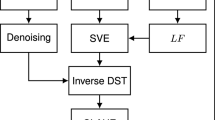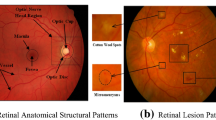Abstract
In medical image processing, the automatic analysis of pathology localization and the anatomical segmentation steps are more important. The Fundus images of Low resolution (LR) are not applicable to detect the retinal disease. The main aim of this paper is to enhance the resolution of the low-resolution retinal images obtained from the cheap imaging devices within less computational time and high accuracy. So, we proposed the fundus image with Super-Resolution and its performance via the Diagnostically Significant Area (DSA). This approach focuses only on the region of Interest (ROI) instead of concentrating on the entire image leading to less computational time by reducing the time complexity. Therefore, the Eigen MR inter-band feature, Energy MR intra-band feature, Shannon entropy and Sensitive Contrast Interest (SCI) are used to capture the clinical data from the selected region. Therefore, the DSA is determined by using Levenshtein based KNN classifier. Because of better classification outcomes, the Bicubic method is employed in the selected region to reduce the loss of reconstruction error. Experimentally, the implementation works are carried out in the platform of MATLAB with DRIVE and STARE database images are chosen. The super-resolution image performances are compared with different start of art techniques such as PSM, GR-SR, LLE, and SpC-SR. Finally, higher efficiency with low computational super-resolution fundus images is collected.






Similar content being viewed by others
References
Gharabaghi S, Dhaneshvar S, Sedaaghi MH (2012) Retinal image registration using geometrical features. J Digit Imaging 26(2):248–258
Mahapatra Dwarikanath, Behzad Rahil (2019) Image super-resolution using progressive generative adversarial networks for medical image analysis. Comput Med Imaging Graph 71:30–39
Das Vineeta, Samarendra Prabin (2019) A novel diagnostic information based framework for super resolution of retinal fundus images. Comput Med Imaging Graph 72:22–33
Hernandez-Matas C, Zabulis X, Antonis AA (2015) Retinal image registration based on key point correspondences, spherical eye modelling and camera pose estimation. In: 2015 annual international conference of the IEEE Engineering Medicine and Biology Society (EMBC), pp 5650–5654
Nagunerii S, Benjamin F, Heinz H, Mike H (2012) Three-dimensional tomography super-resolution fluorescence imaging of serially sectioned thick samples. PLoS ONE 7(5)
Babacan Derin, Ansorge Reto, Luessi Martin, Ruiz Pablo, Molina Rafael (2012) Compressive light field sensing. IEEE Trans Image Process 21(12):4746–4757
Ghassabi Zeinab, Shanbehzadeh Jamshid, Mohammadzadeh Ali (2016) A structure-based region detector for high resolution retinal fundus image registration. Biomed Signal Process Control 23:52–61
Molodij Ribak, Glanc Chenegros (2014) Enhancing retinal images by extracting structural information. Opt Commun 313:321–328
Sundararaj V (2016) An efficient threshold prediction scheme for wavelet based ECG signal noise reduction using variable step size firefly algorithm. Int J Intell Eng Syst 9(3):117–126
Vinu S (2019) Optimised denoising scheme via opposition-based self-adaptive learning PSO algorithm for wavelet-based ECG signal noise reduction. Int J Biomed Eng Technol 31(4):325
Vylala A, Plakkottu Radhakrishnan B (2020) Spectral feature and optimization-based actor-critic neural network for arrhythmia classification using ECG signal. J Exp Theor Artif Intell 32(3):409–435
Anoop V, Bipin PR (2019) Medical image enhancement by a bilateral filter using optimization technique. J Med Syst 43(8):240
Sundararaj V (2019) Optimal task assignment in mobile cloud computing by queue based ant-bee algorithm. Wirel Pers Commun 104(1):173–197
Vinu S, Muthukumar S, Kumar RS (2018) An optimal cluster formation based energy efficient dynamic scheduling hybrid MAC protocol for heavy traffic load in wireless sensor networks. Comput Secur 77:277–288
Rejeesh MR (2019) Interest point based face recognition using adaptive neuro fuzzy inference system. Multimed Tools Appl 78(16):22691–22710
Zhang Y, Wang Y, Zhou G, Jin J, Wang B, Wang X, Cichocki A (2018) Multi-kernel extreme learning machine for EEG classification in brain–computer interfaces. Expert Syst Appl 96:302–310
Zhang Yu, Zhou Guoxu, Jin Jing, Zhao Qibin, Wang Xingyu, Cichocki Andrzej (2015) Sparse Bayesian classification of EEG for brain-computer interface. IEEE Trans Neural Netw Learn Syst 27(11):2256–2267
Avci M, Sarıgül M, Ozyildirim BM (2020) Case study: deep convolutional networks in healthcare. In: Development and analysis of deep learning architectures. Springer, Cham, pp 61–89
Kang Y, Fang Y, Lai X (2020) Automatic detection of diabetic retinopathy with statistical method and Bayesian classifier. J Med Imaging Health Inform 10(5):1225–1233
Singla M, Soni S, Saini P, Chaudhary A, Shukla KK (2020) Diabetic retinopathy detection using twin support vector machines. In: Advances in bioinformatics, multimedia, and electronics circuits and signals. Springer, Singapore, pp 91–104
Chowdhury AR, Chatterjee T, Banerjee S (2019) A Random Forest classifier-based approach in the detection of abnormalities in the retina. Med Biol Eng Comput 57(1):193–203
Cao P, Ren F, Wan C, Yang J, Zaiane O (2018) Efficient multi-kernel multi-instance learning using weakly supervised and imbalanced data for diabetic retinopathy diagnosis. Comput Med Imaging Graph 69:112–124
Koh Bhandary, Laude Acharya (2018) Automated detection of retinal health using PHOG and SURF features extracted from fundus images. Appl Intell 48(5):1379–1393
Peleg T, Elad M (2014) A statistical prediction model based on sparse representations for single image super-resolution. IEEE Trans Image Process 23(6):2569–2582
Liao Xiuxiu, Bai Kejia, Zhang Qian, Jia Xiping, Liu Shaopeng, Zhan Jin (2020) Image super-resolution based on sparse coding with multi-class dictionaries. Comput Inform 38(6):1301–1319
Wang H, Gao X, Zhang K, Li J (2017) Fast single image super-resolution using sparse Gaussian process regression. Signal Process 134:52–62
Liu Y, Ye D, Li W, Wang H, Gao Y (2020) Robust neighborhood embedding for unsupervised feature selection. In: Knowledge-based systems, pp 105462
Maninis K, Jordi L (2016) Deep retinal image understanding. In: International conference of medical imaging, pp 140–148
Staal Joes, Michael Bram (2009) Ridge-based vessel segmentation in color images of the retina. IEEE Trans Med Imaging 23(4):501–509
Nadiarnykh O, Davidaoiu V, Grafe MG, Bosscha M, Boer F (2019) Phase-based OCT angiography in diagnostic imaging of paediatric retinoblastoma patients: abnormal blood vessels in post-treatment regression patterns. Biomed Opt Express 5(6):2213–2226
Klomsae Atcharin, Sansanee Nipon (2017) A string grammar fuzzy-possibility C-medians. Appl Soft Comput 57:684–695
Abintun Juefei, Prabhu Savvides (2019) SSR2: sparse signal recovery for single-image super-resolution on faces with extreme LR. Pattern Recognit 90:308–324
Ganesan K, Rajaguru H (2019) Performance analysis of KNN classifier with various distance metrics method for MRI images. In: Soft computing and signal processing, pp 673–682
Lee H, Battle A, Raina R, Ng AY (2007) Efficient sparse coding algorithms. In: Advances in neural information processing systems, pp 801–808
Author information
Authors and Affiliations
Corresponding author
Ethics declarations
Conflict of interest
The authors declare that they have no conflict of interest.
Human and Animal Rights
This article does not contain any studies with human or animal subjects performed by any of the authors.
Informed Consent
Informed consent was obtained from all individual participants included in the study.
Additional information
Publisher's Note
Springer Nature remains neutral with regard to jurisdictional claims in published maps and institutional affiliations.
Rights and permissions
About this article
Cite this article
Anoop, V., Bipin, P.R. Super-Resolution Based Automatic Diagnosis of Retinal Disease Detection for Clinical Applications. Neural Process Lett 52, 1155–1170 (2020). https://doi.org/10.1007/s11063-020-10292-x
Published:
Issue Date:
DOI: https://doi.org/10.1007/s11063-020-10292-x




